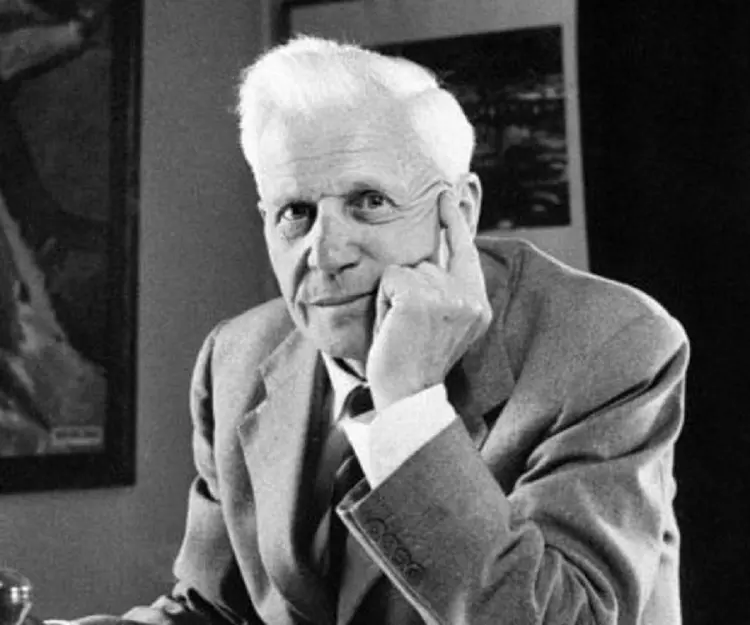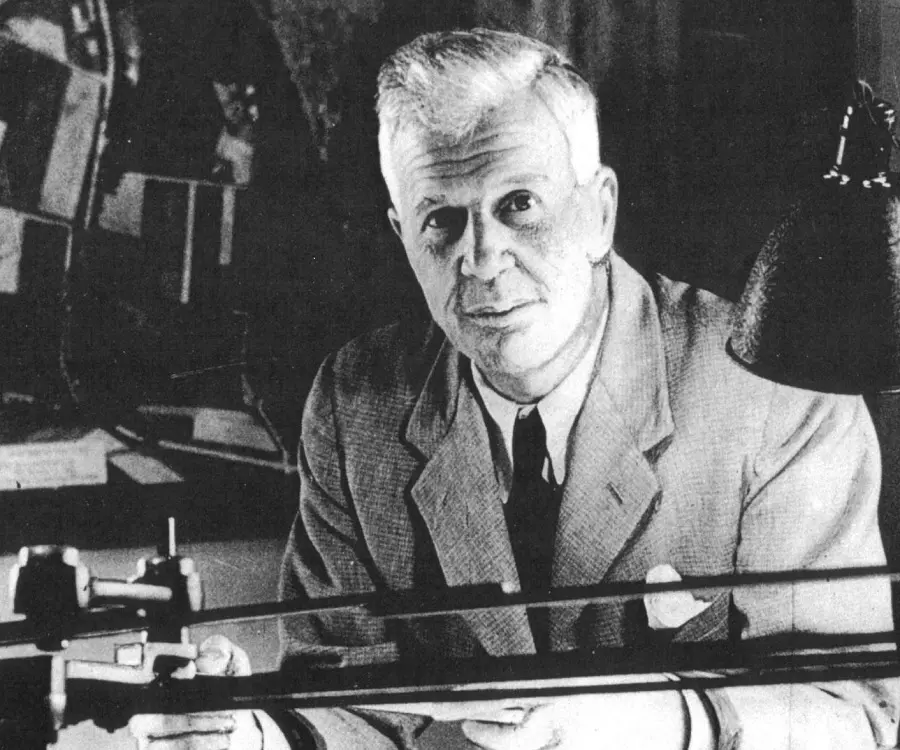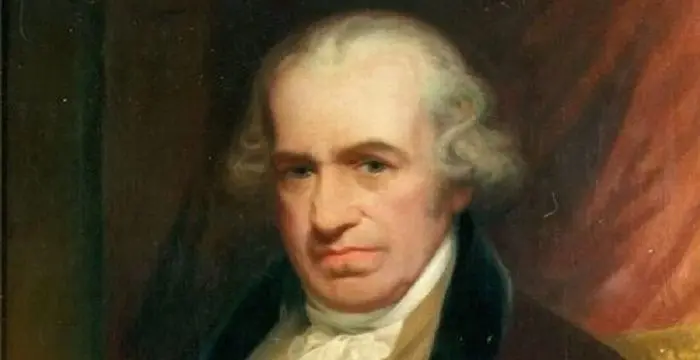
Barnes Wallis - Inventor of Bouncing Bomb, Family and Facts
Barnes Wallis's Personal Details
Barnes Wallis was the English inventor who invented the bouncing bomb that was used in the Dambusters raid of May 1943
| Information | Detail |
|---|---|
| Birthday | September 26, 1887 |
| Died on | October 30, 1979 |
| Nationality | British |
| Famous | Humanitarian, Marine Engineers, Inventors & Discoverers, Inventor of Bouncing Bomb |
| Spouses | Molly Bloxam |
| Universities |
|
| Discoveries / Inventions |
|
| Birth Place | Ripley |
| Gender | Male |
| Sun Sign | Libra |
| Born in | Ripley |
| Famous as | Inventor of Bouncing Bomb |
| Died at Age | 92 |
Barnes Wallis's photo
Who is Barnes Wallis?
Barnes Wallis is best known as the English inventor and scientist who designed and invented the bouncing bomb for the “Dambusters” raid of May 1943. Trained as a marine engineer, Wallis soon found his real calling in aviation industry. After a stint as a marine engineer, he switched to designing airships and engaged himself in aircraft development for Vickers. He played a crucial role in the development of the R100, the largest airship ever designed then. Following aircraft designing, Wallis concentrated his energy on bomb designing. He realized that the best way to destroy Nazi Germany’s ability to wage war is through bombing. He came up with the plan of Dambuster raid that served the purpose with less risk of causalities. For the same, Wallis invented bouncing bomb that attacked the dam walls of the Ruhr valley, disrupting German factories and their hydro-electric power. Though the bombing did not cause much of physical damage, it indeed damaged the German forces psychologically. Throughout the latter life, Wallis engaged himself in aeronautical research.
// Famous Inventors & Discoverers
Nikola Tesla
Nikola Tesla was a Serbian-American inventor, best known for his development of alternating current electrical systems. This biography of Nikola Tesla provides detailed information about his childhood, life, achievements, works & timeline.
Thomas Newcomen
Thomas Newcomen was a British inventor who developed the world’s first steam engine. Browse through this biography to learn in details about his life, career, works and timeline.
Erno Rubik
The famous inventor and educationist, Erno Rubik is known world-wide for his invention the ‘Rubik’s Cube’. To know more about the childhood, profile, timeline and career of this famous architect-inventor read on.
Childhood & Early Life
Barnes Wallis was born on September 26, 1887 in Ripley, Derbyshire to Charles Wallis and Edith Ashby. He was the second of the four children born to the couple.
When young Wallis turned two, the family moved to New Cross Road in London where his father practiced as a doctor. In 1893, he contracted poliomyelitis, a fatal disease that left him crippled.
Since a young age, Wallis was interested in creating things. Along with his brother, he made paper toys for his little sister at their workshop.
Academically brilliant, he received his education from Christ’s Hospital school. At the school Wallis developed an affinity for mathematics and science, and decided to become an engineer.
Career
Upon leaving school in 1905, Wallis commenced his career for Thames Engineering Works, a ship engine building firm. He apprenticed there until 1908.
In 1908, he joined John Samuel White’s shipyard in the Isle of Wight as a marine engineer. Ambitious and futuristic, Wallis left his job in 1913 and instead found employment at Vickers, a company that dealt with airship and aircraft development.
Trained as a marine engineer, Wallis knew nothing about airships and air travel. Despite being ignorant, he soon equipped himself with knowledge about airships and air travel. Meanwhile, in 1922, he took a degree in engineering via the University of London External Programme.
When World War I broke out, Wallis was briefly unemployed as Admiralty refused expending money on airship development. He decided to serve the army but was recalled by Vicker’s airship development team
In 1930, Wallis involved himself in the development of R100. His career feat of this time includes the first use of geodetic design in engineering and in gasbag wiring. He helped in the building of the then largest airship ever designed. He also assisted John Edwin in the structural designing of R100.
Wallis moved to the Vickers aircraft factory at Brooklands. Therein, his geodetic design was employed in all the pre-war aircraft designs of Wellesley, Wellington and Warwick in fuselage and wing structure.
When Second World War broke out, Wallis was appointed as the assistant chief designer at Vicker’s aviation section. He soon realized the need for strategic bombing to cripple the enemy’s ability to start war. For the same, he penned a paper, ‘A Note on a Method of Attacking Axis Power’.
Wallis suggested that the quickest way to defeat the enemy was to destroy its industrial base. No factories would mean no war supplies and hence no war. To implement his plan, he researched and found Ruhr to be the most important industrial base for Nazi Germany.
Wallis came up with the idea that bombing dams would quintessentially serve the purpose of disrupting industrial base. Breaching of dams would lead to a powerful supply of restrained water that in turn would destroy all things in its path.
Working on his idea of bombing dams, he developed a drum-shaped, rotating bomb that would bounce over the water, roll down the dam's wall and explode at its base. This would lessen the risk of aircraft damage and increase the range of the bomb.
Impressed by the idea of bouncing bomb, the Air Force gave the green signal to Wallis. They ordered Wallis to prepare bombs for an attack on Mohne, Eder and Sorpe dams in the industrial area of Ruhr in Germany. The bomb was codenamed ‘Upkeep’.
The Dambuster raid, named Operation Chastise, took place on 16th and 17th of May, 1943 by the specially created 617 Squadron of Royal Air Force. Two dams, Mohne and Eder, were breached and caused serious damage to German industrial base and disrupted hydro-electric power. Though the physical impact of the Dambuster raid wasn’t as Wallis had expected it to be, it however shook the Axis Forces psychologically.
Following the success of the bouncing bomb, Wallis came up with ‘Tallboy’ and ‘Grand Slam’ bomb. While the former weighed at 6 tonnes, the latter was 10 tonnes. They were used on strategic targets such as V-2 rocket launch sites, submarine pens, large civil constructions and the German battleship Tirpitz.
At the end of Second World War, Walllis returned to Brooklands as Head of the Vickers-Armstrongs Research & Development Department. He dedicated his latter half of the career in designing futuristic aerospace projects such as swing-wing technology, supersonic flight and so on.
In the 1950s, Wallis came up with a rocket-propelled torpedo, HEYDAY, which was powered by compressed air and hydrogen peroxide. He designed non-misting glassless mirror made out of non-flammable and unbreakable polyester. In 1955, he acted as a consultant for the building of the Parkes Radio Telescope in Australia.
The better part of the decade of 1960s was dedicated to developing ideas for ‘all-speed’ aircraft. He proposed an aircraft that would be capable of efficient flight at all ranges from subsonic to hypersonic.
Major Works
The highpoint of Wallis’ career came with the invention of the bouncing bomb, named Upkeep, which was used by Royal Air Force, during the Dambuster raid of May 1943. Named Operation Chastise, Wallis’ bouncing bomb was used to attack the dam of Mohne, Eder and Sorpe in the Ruhr area during World War II. He believed that by breaching the dam wall they would destroy Nazi Germany’s industrial base and thus disrupt the latter’s war schemes.
Awards & Achievements
In 1945, Wallis was made Fellow of the Royal Society.
In 1968, he was knighted for his contribution as an engineer and inventor. Furthermore, he received £10,000 from the Royal Commission on Awards to Inventors for his invention of the bouncing bomb.
Personal Life & Legacy
Wallis first met his future wife, Molly Bloxam during a family tea party. The two hit it off instantly. Though Bloxam’s father forbade her from courting Wallis, the two remained in touch through letters. The couple soon became inseparable. They tied the nuptials on April 23, 1925.
The couple was blessed with four children, Barnes, Mary, Elisabeth and Christopher. Additionally, they adopted Molly’s sister’s children after they became orphans.
He breathed his last on October 30, 1979, in Effingham, Surrey, England. He was buried at the local St Lawrence Church.
For his remarkable contribution as an inventor and engineer, Wallis has been commemorated vastly. He has public houses named after him. Furthermore, a building in Nottingham Trent University bears his name. His statues, busts and plaques adorn numerous sites across the globe.
The Yorkshire Air Museum has a permanent display of the Dambusters raid. It comprises of a replica bouncing bomb and the catapult used to skim stones to test the bouncing bomb theory. To keep the visitors well-informed, a brief history of Wallis’ work is also displayed.
There are roads, drives and squares named after Barnes Wallis. He has been the fictional character of several books. Interestingly, in golf, a shot that bounces over the surface of a water hazard has been named Barnes Wallis
// Famous Humanitarian
Joyce Meyer
Joyce Meyer is a Christian author and speaker. This biography provides detailed information about her childhood, life, achievements, works & timeline
Swami Vivekananda
Swami Vivekananda was the chief disciple of Sri Ramakrishna, and was responsible for awakening India spiritually. Check this biography to know in detail about his life, profile and timeline.
Nicole Kidman
Nicole Kidman is one of the most talented actors that the Hollywood film industry can boast of. Browse through this biography to get detailed information regarding her life, childhood, profile & timeline
Barnes Wallis biography timelines
- // 26th Sep 1887Barnes Wallis was born on September 26, 1887 in Ripley, Derbyshire to Charles Wallis and Edith Ashby. He was the second of the four children born to the couple.
- // 1893When young Wallis turned two, the family moved to New Cross Road in London where his father practiced as a doctor. In 1893, he contracted poliomyelitis, a fatal disease that left him crippled.
- // 1905 To 1908Upon leaving school in 1905, Wallis commenced his career for Thames Engineering Works, a ship engine building firm. He apprenticed there until 1908.
- // 1908 To 1913In 1908, he joined John Samuel White’s shipyard in the Isle of Wight as a marine engineer. Ambitious and futuristic, Wallis left his job in 1913 and instead found employment at Vickers, a company that dealt with airship and aircraft development.
- // 1922Trained as a marine engineer, Wallis knew nothing about airships and air travel. Despite being ignorant, he soon equipped himself with knowledge about airships and air travel. Meanwhile, in 1922, he took a degree in engineering via the University of London External Programme.
- // 23rd Apr 1925Wallis first met his future wife, Molly Bloxam during a family tea party. The two hit it off instantly. Though Bloxam’s father forbade her from courting Wallis, the two remained in touch through letters. The couple soon became inseparable. They tied the nuptials on April 23, 1925.
- // 1930In 1930, Wallis involved himself in the development of R100. His career feat of this time includes the first use of geodetic design in engineering and in gasbag wiring. He helped in the building of the then largest airship ever designed. He also assisted John Edwin in the structural designing of R100.
- // May 1943The highpoint of Wallis’ career came with the invention of the bouncing bomb, named Upkeep, which was used by Royal Air Force, during the Dambuster raid of May 1943. Named Operation Chastise, Wallis’ bouncing bomb was used to attack the dam of Mohne, Eder and Sorpe in the Ruhr area during World War II. He believed that by breaching the dam wall they would destroy Nazi Germany’s industrial base and thus disrupt the latter’s war schemes.
- // 17th May 1943The Dambuster raid, named Operation Chastise, took place on 16th and 17th of May, 1943 by the specially created 617 Squadron of Royal Air Force. Two dams, Mohne and Eder, were breached and caused serious damage to German industrial base and disrupted hydro-electric power. Though the physical impact of the Dambuster raid wasn’t as Wallis had expected it to be, it however shook the Axis Forces psychologically.
- // 1945In 1945, Wallis was made Fellow of the Royal Society.
- // 1955In the 1950s, Wallis came up with a rocket-propelled torpedo, HEYDAY, which was powered by compressed air and hydrogen peroxide. He designed non-misting glassless mirror made out of non-flammable and unbreakable polyester. In 1955, he acted as a consultant for the building of the Parkes Radio Telescope in Australia.
- // 1968In 1968, he was knighted for his contribution as an engineer and inventor. Furthermore, he received £10,000 from the Royal Commission on Awards to Inventors for his invention of the bouncing bomb.
- // 30th Oct 1979He breathed his last on October 30, 1979, in Effingham, Surrey, England. He was buried at the local St Lawrence Church.
Barnes Wallis's FAQ
What is Barnes Wallis birthday?
Barnes Wallis was born at 1887-09-26
When was Barnes Wallis died?
Barnes Wallis was died at 1979-10-30
Where was Barnes Wallis died?
Barnes Wallis was died in Effingham, Surrey
Which age was Barnes Wallis died?
Barnes Wallis was died at age 92
Where is Barnes Wallis's birth place?
Barnes Wallis was born in Ripley
What is Barnes Wallis nationalities?
Barnes Wallis's nationalities is British
Who is Barnes Wallis spouses?
Barnes Wallis's spouses is Molly Bloxam
What was Barnes Wallis universities?
Barnes Wallis studied at Christ's Hospital
What is Barnes Wallis's inventions/discoveries?
Bouncing Bomb was invented (or discovered) by Barnes Wallis
What is Barnes Wallis's sun sign?
Barnes Wallis is Libra
How famous is Barnes Wallis?
Barnes Wallis is famouse as Inventor of Bouncing Bomb







